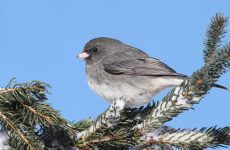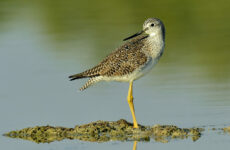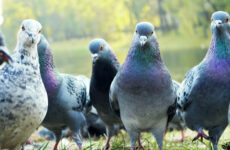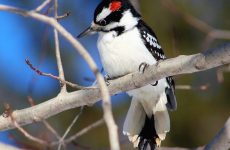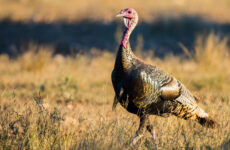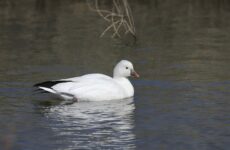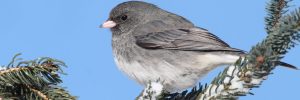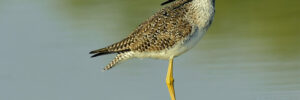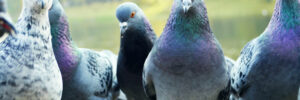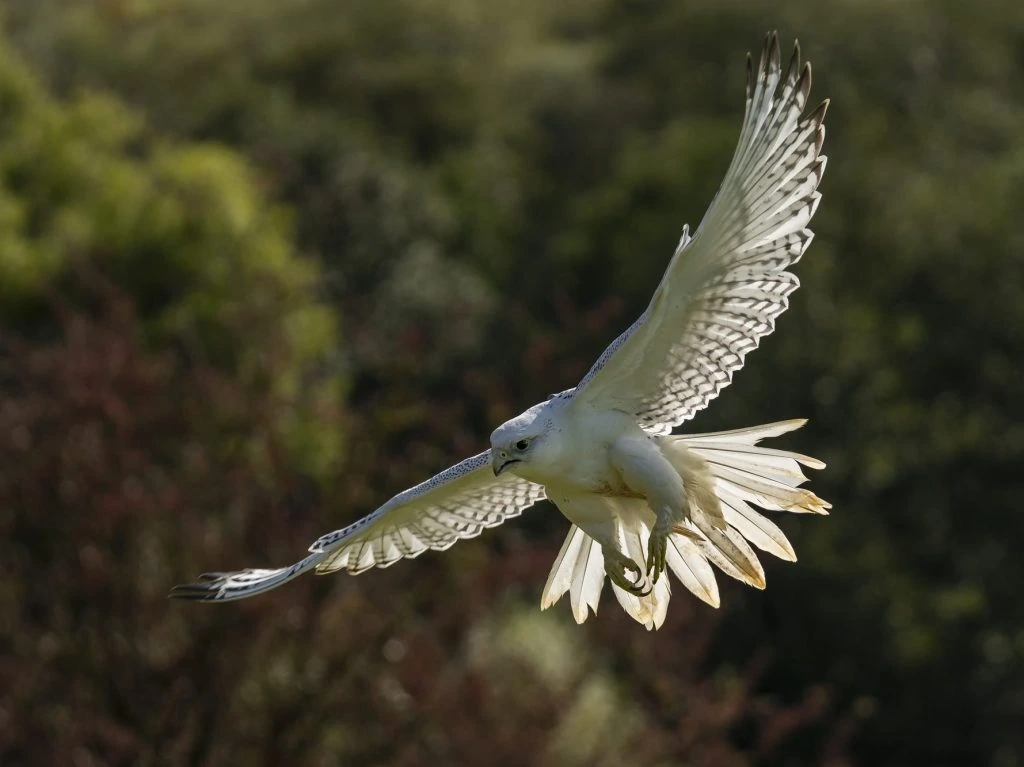
Six of the eleven types of Falcons found in North America have been spotted in Pennsylvania. Three of these are regularly occurring (common) and three are rare or accidental species in the state. The common types are the American Kestrel, Merlin, and Peregrine Falcon.
Falcons are small and incredibly fast birds of prey that have the honor of having the fastest and the smallest bird of prey in North America. The Peregrine Falcon is the fastest bird of prey and the American Kestrel is the smallest bird of prey. Also, the Gyrfalcon is the largest falcon in the world and it also lives in North America.
So there certainly are some top birds to spot if you like birds of prey.
With species of falcons on every continent, except Antarctica, these birds are a bird to be reconned with. They have amazing characteristics which make them unique.
Other types of birds of prey you can spot in Pennsylvania include hawks, owls, eagles, and vultures.
Falcons have thin, tapered wings that enable them to fly faster than a cheetah and turn with immense speed. Their beaks have a special tomial ‘tooth’ that they use to kill their prey, instead of their talons like most birds of prey.
Falconry is the name given to hunting with captive-trained birds, which has been practiced for thousands of years. A common bird to use is a peregrine falcon.
Falcons are different than hawks as they belong to different families, hawks are Accipiter genus and falcons are Falco genus. Also, falcons are usually smaller and they have long thin wings rather than wide short wings like those of hawks. Falcons hunt in open spaces but hawks are often found in woodland.
Falcons in Pennsylvania all year: American Kestrel
Falcons in Pennsylvania in winter: Merlin, Peregrine Falcon
Rare or accidental Falcons in Pennsylvania: Prairie Falcon, Gyrfalcon, Crested Caracara
So what are you waiting for, see how many falcons you can spot in Pennsylvania.
6 Falcons in Pennsylvania
1. American Kestrel
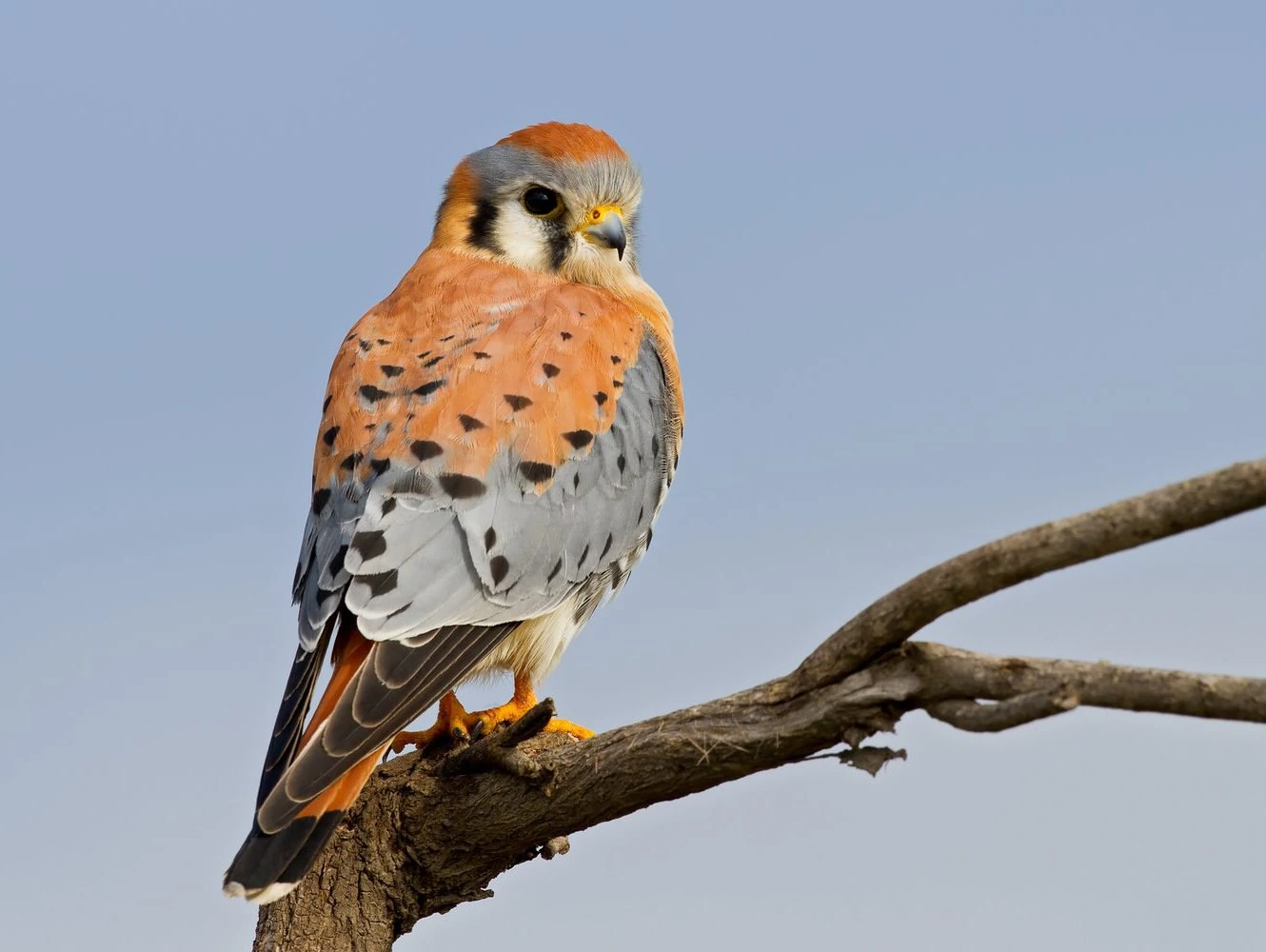
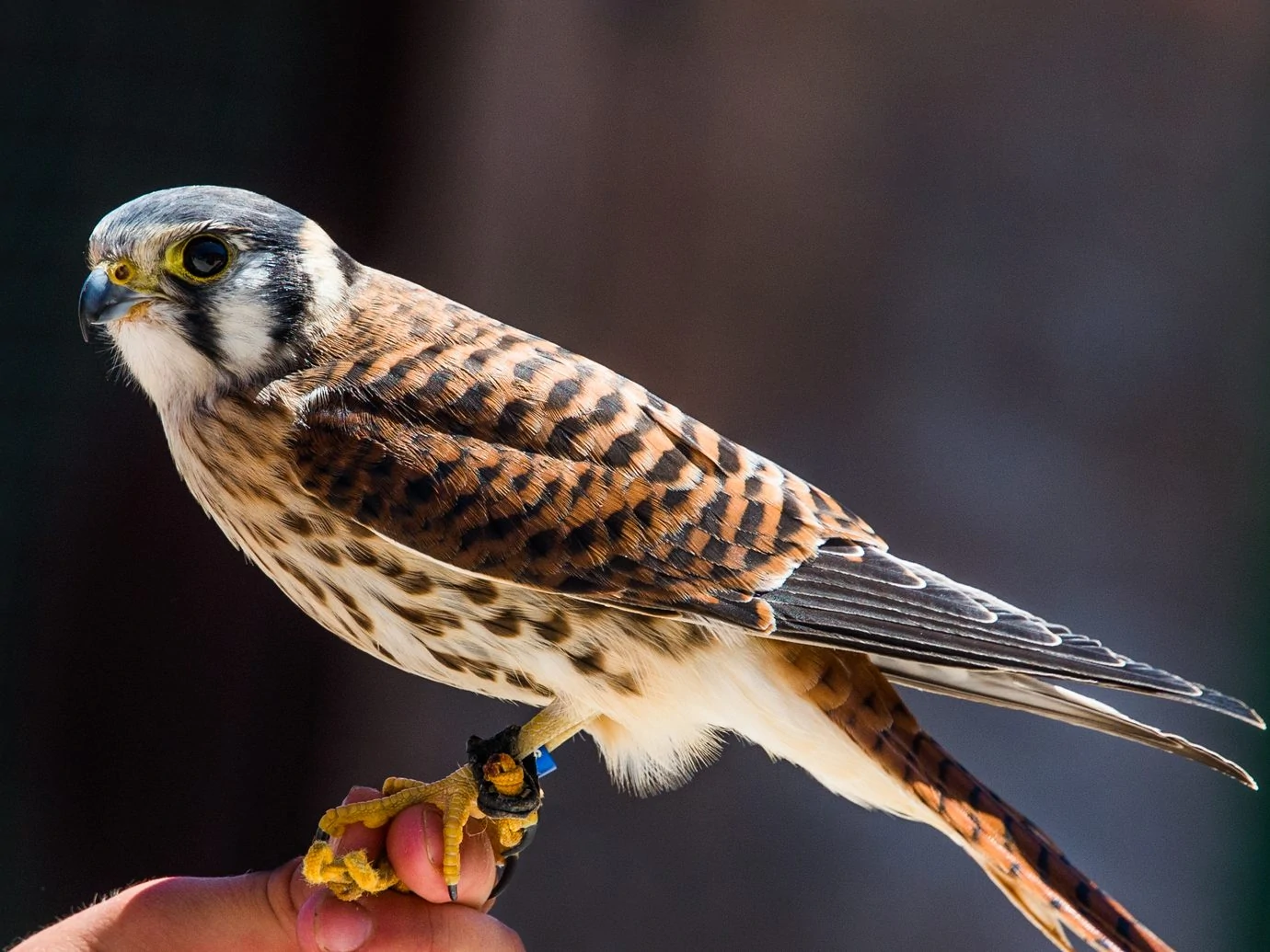
American Kestrels are common in Pennsylvania and are spotted in the state all year. They are recorded in up to 3% of summer and winter checklists submitted by bird watchers for the state.
American Kestrels are the smallest and most colorful falcons in North America. Males and females have different colors and markings.
Adult Male American Kestrels have dark gray heads with varying amounts of rufous on the crown, white throats, blue-black bills, and unique vertical slashes on their white faces – one under their eyes and another behind their eyes. This is significant because most falcons only have one.
Their bellies and breasts are orange with brown spots, their backs are red-brown, their wings are blue-gray with white spotting, and they have yellow legs and feet. Their underwings appear spotted. Their tails are reddish-brown with one broad black band and a white tip.
Female American Kestrels share similar traits with the males – rufous crowns, gray heads, white faces, and two black vertical slashes on the face. They also both have two black spots at the back of their heads that deceives potential attackers when hunting from the rear.
However, female American Kestrels have a general rufous coloring, particularly on their backs and wings, and their barring is more pronounced. They have white bellies and breasts with rufous streaks. Their tails are also reddish-brown with many bars.
- Falco Sparverius
- Length: 9 – 12 in (23 – 30 cm)
- Weight: 3.9 oz (111 g)
- Wingspan: 20 – 25 in (51 – 64 cm)
American Kestrels are the most common falcon with seventeen subspecies living in varied environments and habitats across the Americas. With many subspecies, American Kestrels have plenty of regional variation in their coloring, markings, and vocalizations.
American Kestrels are found in North and South America. Those that breed in Canada migrate south for winter, but the rest remain resident all year.
You can find American Kestrels mainly in open areas without dense cover as they prefer viewing their whole territory from a single perch.
They typically live in grasslands, pastures, plains, meadows, agricultural fields, deserts, and even urban environments. You may see them perched on fence posts, lone trees, and low shrubs.
Since American Kestrels can inhabit a wide range of environments, they can also have a diverse range of prey. They can hunt and eat grasshoppers, crickets, cicadas, beetles, and dragonflies. What they do is sit and wait on a perch. When they have their prey in sight, they either catch it on the ground or while in flight.
American Kestrels can also hunt by hovering while scanning for prey on the ground.
They may use this strategy when hunting mice, voles, lizards, frogs, and small birds. American Kestrels only attack when they’re sure that they will succeed.
American Kestrel Call:
Nests of American Kestrels include abandoned nests of woodpeckers or other birds, their own tree cavities which they’re reusing, their old nesting sites along cliff ledges and tops of buildings, and tree holes or cavities in cactuses. They also make use of artificial nest boxes.
Female American Kestrels usually lay up to seven eggs. Incubation begins only when all eggs have been laid. The female incubates the eggs for about a month. During this time, the male hunts for food and feeds his bounty to the female. He may sometimes assist in incubation to let the female hunt on her own.
Attracting American Kestrels to your backyard is possible if you put up nest boxes that are within their preferred habitats. They need a perch and open area and preferably with no outdoor pets.
Fun Fact: American Kestrels can see using ultraviolet light which comes in handy when trying to hunt their prey. It is especially handy when seeing the trails of urine that are left by voles that allow the American Kestrels to pinpoint their exact location.
2. Merlin
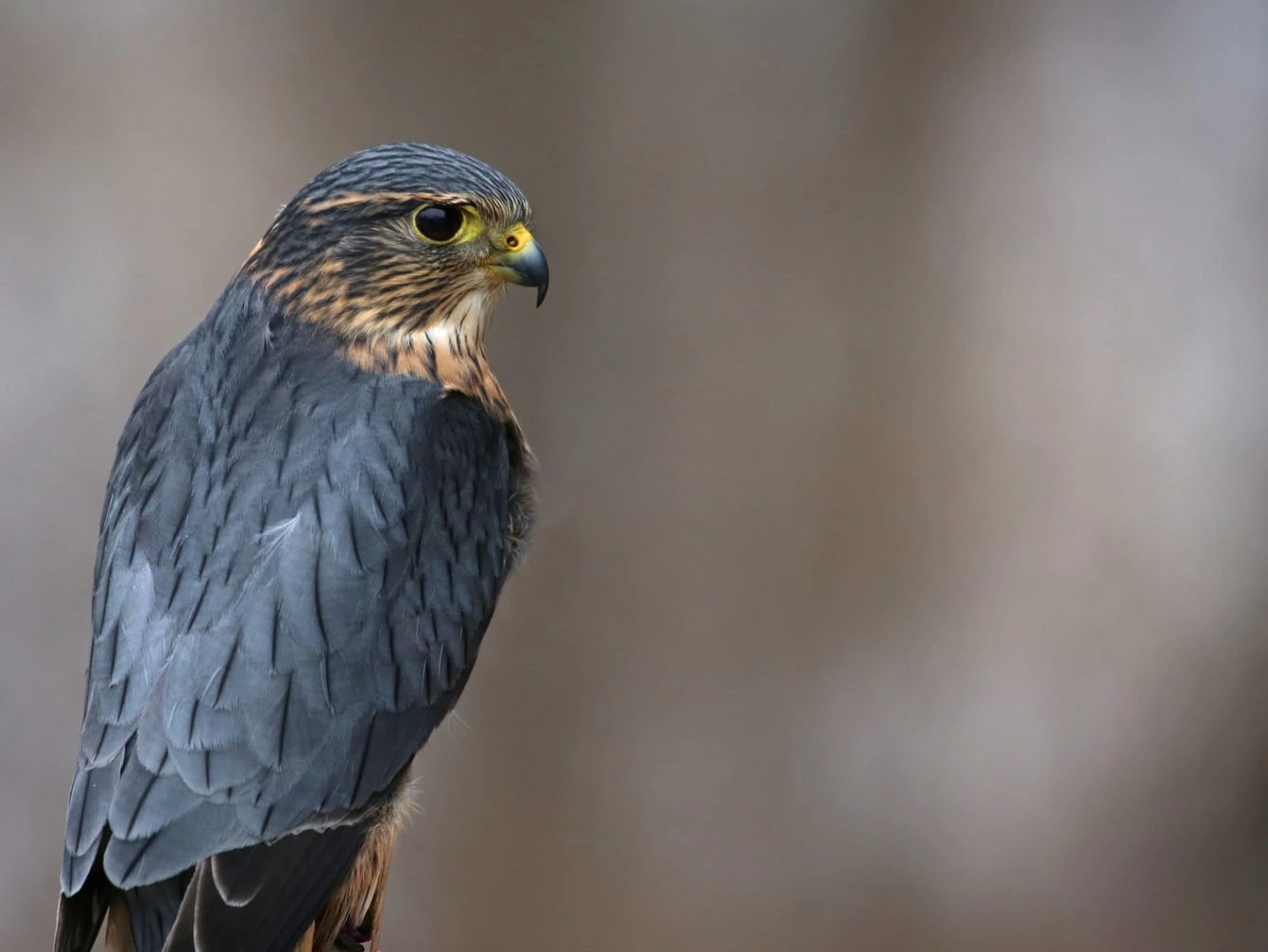
Merlins spend winter in Pennsylvania but they are most common during migration from September to mid-November. They occur in up to 3% of checklists at this time.
Merlins are small but fierce falcons that have as many as nine subspecies, three are in North America and the rest are in Europe and Asia. In North America, these three subspecies have varying degrees of coloration depending on their geographic location.
The Black Merlin, Pacific Northwest or Coastal Forest Merlins are very dark blue almost black with white or brown-streaked undersides. The Taiga Merlins have intermediate coloring and Prairie Merlins are the palest of the three.
They are all darker on the back and paler on the underside, but this may range from white to brown. They have small hooked bills and yellow skin at the base of their dark bills and around their dark eyes.
- Falco columbarius
- Length: 11 – 13 in (28 – 33 cm)
- Weight: 7.4 oz (210 g)
- Wingspan: 23 – 26 in (58 – 66 cm)
Merlins breed in Canada, Alaska, and northern US states before migrating into the rest of the US, and down into northern South America. They also breed in northern Europe and migrate to southern Europe and the Middle East for winter.
You can find Pacific Northwest Merlins in coastal areas, Prairie Merlins in open areas with shrubs, and Taiga Merlins near forested openings near water. Merlins are slowly moving into urban areas too.
Merlins are usually on the hunt for small birds, whichever has the most supply in their habitat. They attack from the air, chasing their prey at high speed until their prey becomes exhausted.
Breeding pairs also hunt together, with one bird flushing out prey from the ground and the other catching the disturbed prey from above. They will also supplement their main diet with other animals like insects and reptiles.
Merlin Call:
Nests of Merlins are mostly in cliffs and tree cavities without the adults adding any material to them. Sometimes, they will use abandoned birds’ nests. What’s important for Merlins is that they be able to see over their territory. The female lays four to five eggs and will incubate them for about a month.
Fun Fact: Merlins were once known as “Pigeon Hawk” in North America.
3. Peregrine Falcon
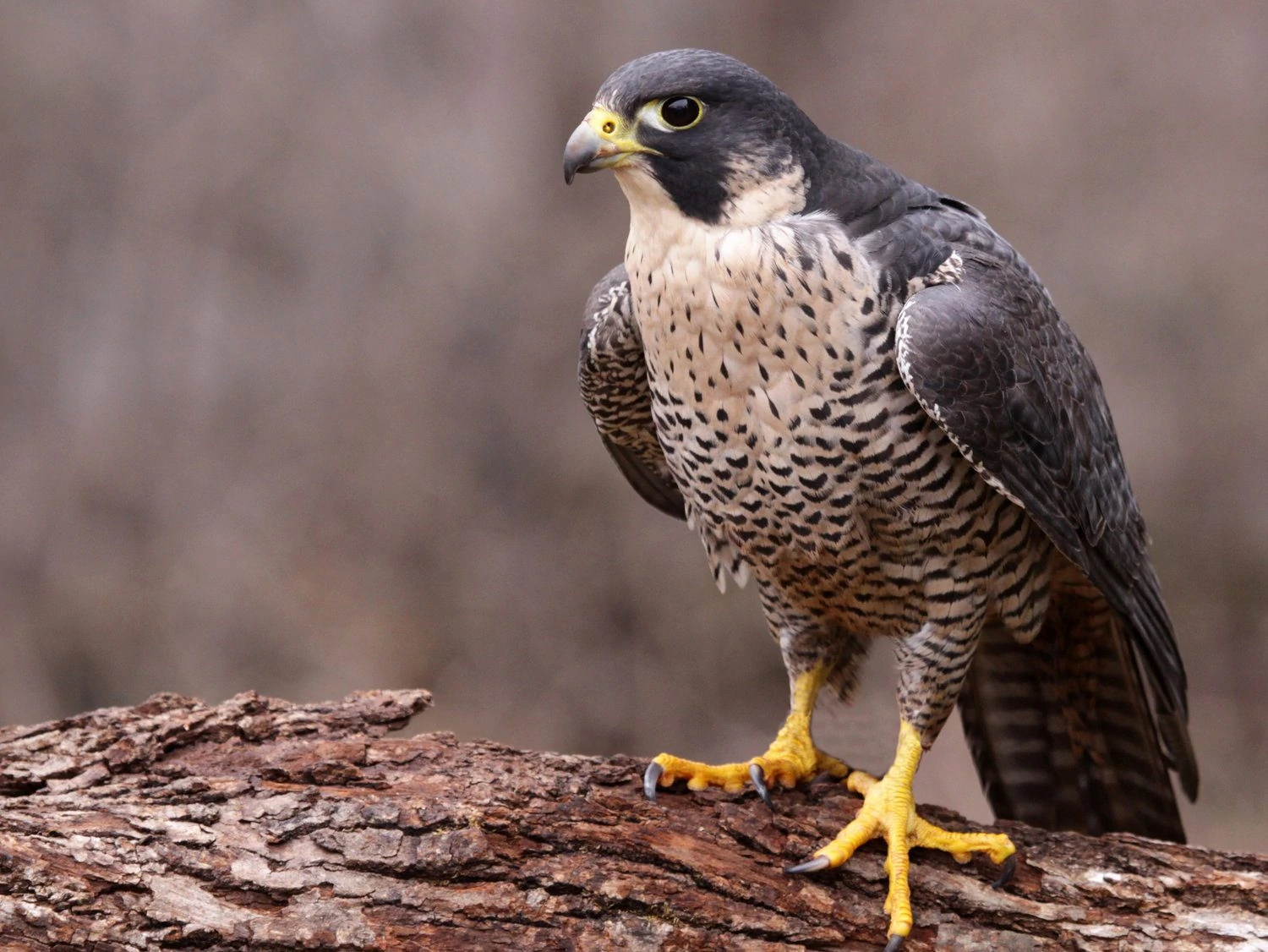
Peregrine Falcons are spotted during winter in southeastern Pennsylvania but they are most common during migration from September to October.
The Peregrine Falcon holds several distinctions. It is known as the fastest bird in the world, the fastest of all animals, and it is also the world’s most widespread raptor.
Peregrine Falcons are dark on the back and lighter underneath and they appear to have dark gray to black hoods on their heads. Their tails are bluish-black with bars, a black tip, and white rims. They have yellow legs and feet.
They have predominantly dark heads with bright yellow earrings, yellow ceres (base of the bill), and gray-to-black hooked bills. Their backs and wings are bluish-black with faint barring and black wingtips. Their underwings, flanks, bellies, and thighs are heavily barred with black and white.
Their throats and breasts may be all-white but sometimes they are spotted or barred.
Females are larger but similarly colored as the males. Juveniles generally have brown coloring and they have heavily streaked underneath. Their eyerings and ceres are also bluish, instead of yellow.
- Falco peregrinus
- Length: 16 – 20 in (41 – 51 cm)
- Weight: 52.91 oz (1499 g)
- Wingspan: 43 – 46 in (109 – 117 cm)
Peregrine Falcons are widespread throughout the world. In North America, they breed predominantly in the arctic and migrate to coastal and southern states.
You can find Peregrine Falcons anywhere in the world except Antarctica. They prefer mountain ranges, open landscapes with cliffs, along rivers and coastlines, and more recently, in urban areas. Generally, they will stay in habitats that have an abundant supply of prey.
Peregrine Falcons are expert hunters, dive-bombing birds, practically any size, at extremely high speeds. Their typical prey include ducks, pigeons, jays, larks, ptarmigans, and starlings. On occasion, they may kill and eat bats and sometimes steal prey like fish and rodents from other hunting birds.
Peregrine Falcon Call:
Nests of Peregrine Falcons are usually on cliff ledges, up to 1,300 feet high. In urban areas, they are mostly found on skyscrapers and tall bridges. In other regions, they use tree hollows for nests.
Typical nests are scrapes where the female “scrapes” a depression in the earth (either soil, sand, or gravel) and where she lays two to six eggs. Both parents take turns incubating the eggs for as many as thirty-three days with the male taking the day shift and the female at night.
Fun Fact: The Peregrine Falcon was considered an Endangered Species from the 1950s to the 1970s because of DDT poisoning. When this pesticide was banned, the species began to thrive again. Today, it’s considered a species of Least Concern.
4. Prairie Falcon
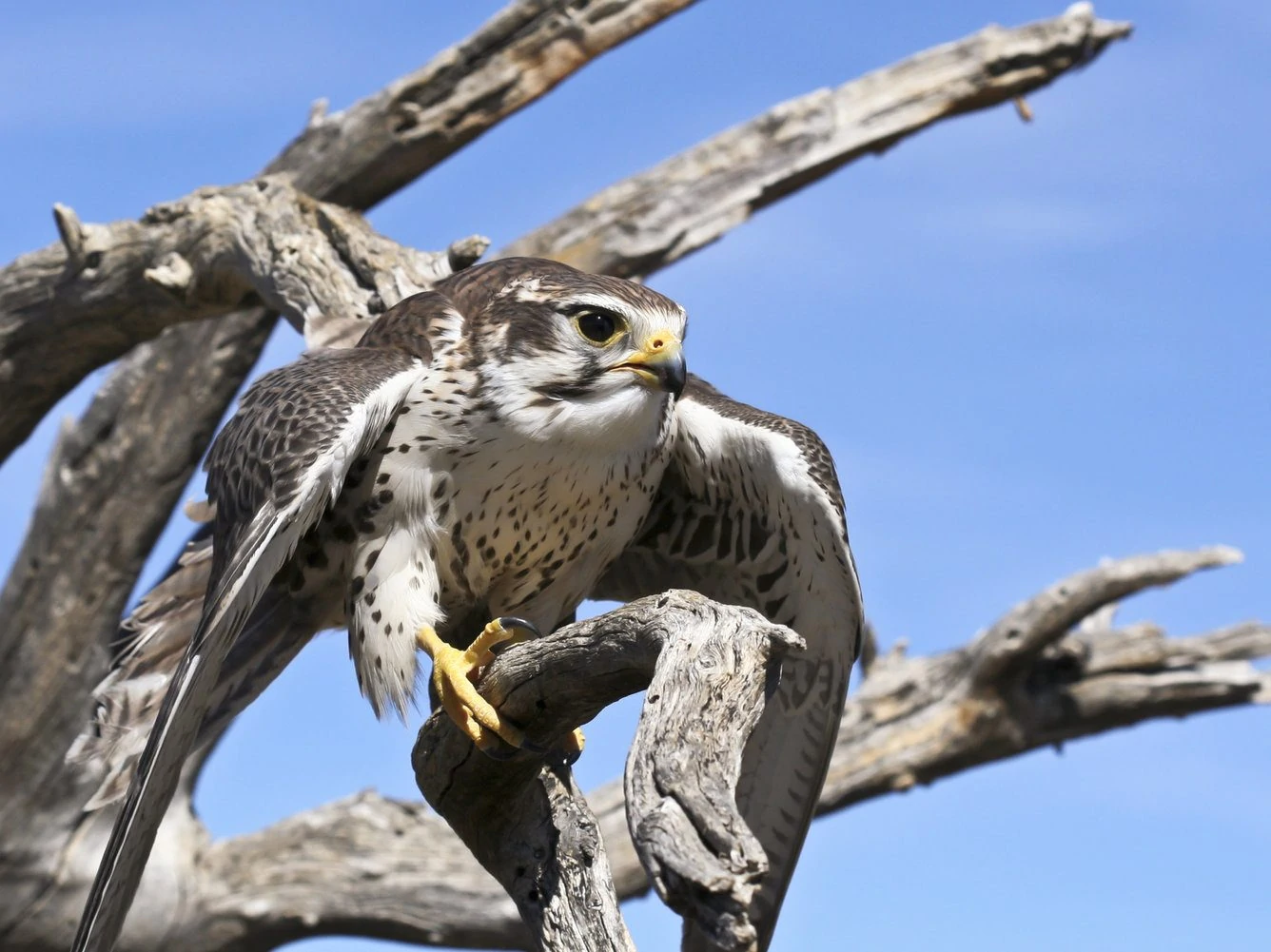
Prairie Falcons are considered rare or accidental species in Pennsylvania and they were last spotted around Shippensburg in 2014.
Prairie Falcons are the arid-environment counterparts of peregrine falcons although they’re lighter and need less food than the peregrines. They are sandy-brown on their crowns, napes, backs, and wings.
They have a thin, dark mustache stripe on their faces, white cheeks, and eyebrows. Their underparts are also white with neat brown spotting. Their tails are lighter-colored than their wings and when in flight, they have visible “armpit” feathers that are unique to them.
Females are similar to males except that they’re larger. Juveniles are also the same as the adults but they are darker in color and have heavy brown streaking on their underparts. Their ceres (base of the bill) and legs are grayish.
- Falco mexicanus
- Length: 15 – 19 in (38 – 48 cm)
- Weight: 19.2 oz (544 g)
- Wingspan: 40 – 42 in (102 – 107 cm)
Prairie Falcons are widespread in western US states and can also be found in southwestern Canada and northern Mexico.
You can find Prairie Falcons in open areas like prairies, dry plains, and barren mountains, with cliffs and buffs for nesting. They also frequent grasslands, agricultural fields, alpine tundra, and high desert.
The diet of Prairie Falcons is mostly small mammals and small to medium-sized birds. When looking for prey, Prairie Falcons prefer to hunt and stalk prey smaller than themselves so that they’re easier to kill.
Prairie Falcons can easily kill ground squirrels, prairie dogs, chipmunks, sparrows, doves, quail, pigeons, mallards, and even lizards and snakes. When nesting, they will hunt prey that they can carry home for their young and their females. They are also known to stash food in separate sites in case hunting is not successful.
Prairie Falcon Call:
Nests of Prairie Falcons are often found on ledges on a cliff, halfway up the cliff face to prevent predators from reaching them. They will also make use of both natural and artificial crevices as nests. They may also nest in trees, caves, and on top of buildings.
Prairie Falcons’ nests are just scrapes or depressions which hold the eggs. The female lays around two to six eggs that she alone incubates roughly for about forty days. During this time, the male hunts and feeds her. It takes around sixty-five days for the young to be self-sufficient.
Fun Fact: Prairie Falcons can dive at speeds of up to 120 mph in their pursuit of food.
5. Gyrfalcon
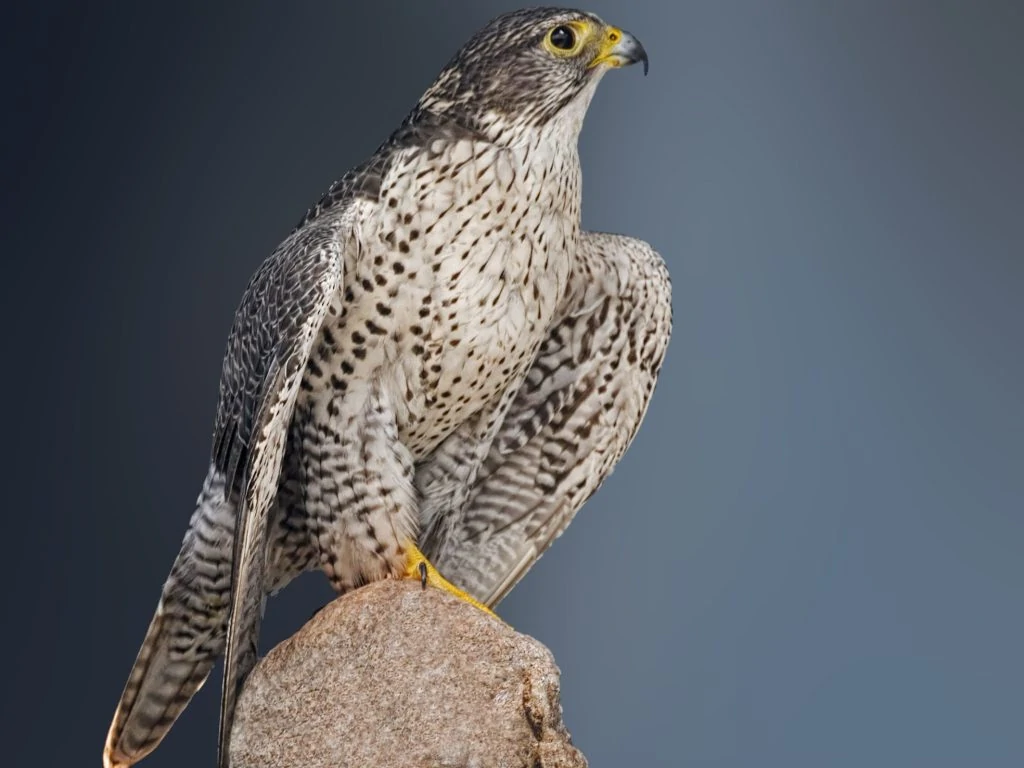

Gyrfalcons spend winter in Pennsylvania and although they have been spotted here from October to March, they are extremely rare and are considered accidental species in the state.
Gyrfalcons are the largest Falcons and are apex predators of the Arctic, where they snatch birds from the sky or dive at great speed to catch unsuspecting prey from the ground.
Their coloring varies greatly but generally has three morphs – white, silver/gray, and dark. Silver/gray is most common in North America
The silver/gray morphs are heavily banded gray and white on their upperparts but some are mostly gray without obvious banding. Their underparts are evenly spotted and white at the throat. Juveniles have solid dark heads and are browner overall.
The White morphs of Gyrfalcons are white with brown/black barring on their upperparts with dark wingtips and a white tail. Some birds have barring on their tails and spots on their breasts. Juveniles are similar but have more barring on their upperparts but have faint streaks on their underparts.
- Falco rusticolus
- Length: 20 – 25 in (51 – 64 cm)
- Weight: 41.6 oz (1179 g)
- Wingspan: 48 – 64 in (122 – 163 cm)
Gyrfalcons breed in the high arctic of Canada before migrating south across Canada and northern US states, those that breed further south in the arctic remain all year. They are also found in Europe.
You can find Gyrfalcons in one of the harshest places on earth, the arctic tundra. They usually stay on cliffs near shorelines or rivers and with a vast open space where they can easily hunt prey. When they migrate during the winter, they stay in areas with plenty of birds for them to hunt, like coasts, reservoirs, grasslands, farmlands, and river valleys.
Gyrfalcons primarily hunt ptarmigans and waterfowl but they also hunt and eat songbirds. Their diet is not limited to birds since they also prey on hares, ground squirrels, and arctic foxes.
They may hunt low by cruising near the ground to scare birds and animals and immediately grab them with their talons. When hunting while flying, they usually strike down their prey from above and let them fall to the ground. They will then retrieve it.
Gyrfalcon Call:
Nests of Gyrfalcons are often found on cliffs. They don’t build their own nests but instead make use of abandoned nests of other birds. The female lays up to five eggs and she incubates them for as many as thirty-six days.
Fun Fact: When the chicks aren’t able to finish off their meal, the female Gyrfalcon will keep or store their leftovers behind some vegetation to retrieve for later.
6. Crested Caracara
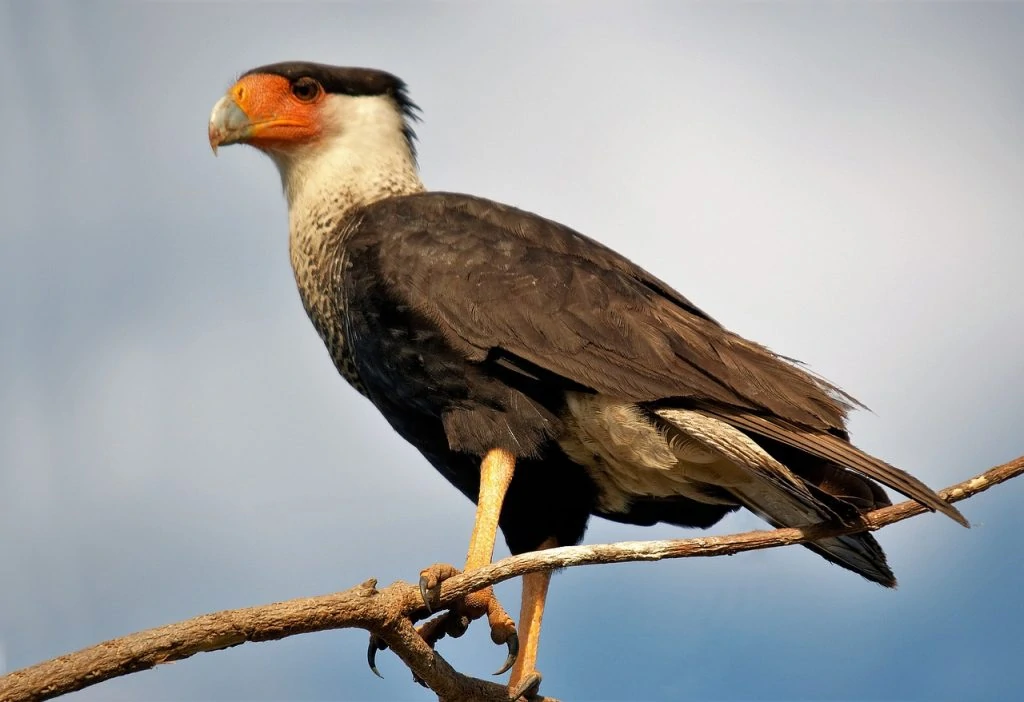
Crested Caracaras are extremely rare birds to see in Pennsylvania but they have been accepted by the Pennsylvania Ornithological Records Committee, as accidental species under their review lists.
Crested Caracaras are large, dark-bodied falcons with distinctive flat heads with black scruffy crowns, and massive orange bills with gray tips. These chunky birds feed on carrion and are aggressive to other birds such as vultures muscling in on their food.
Their throats and rumps are white as are their breasts but with black fine barring. Their bellies and wings are black. Their tails are white with black barring and a thick black band at the tip. Their legs and feet are yellow.
Southern Crested Caracaras are browner than Northern Crested Caracaras which are more black.
Juveniles of both Crested Caracaras look similar to the adults except they’re browner. They have gray or purple facial skin, a buff neck and throat, white with brown streaking on the chest, neck, and back and grayish legs and feet.
- Caracara cheriway
- Length: 20 – 25 in (51 – 64 cm)
- Weight: 33.6 oz (952 g)
- Wingspan: 45 – 48 in (114 – 122 cm)
Crested Caracara do not migrate and are found in Central and South America, Mexico, and southern US states. They are also spotted more sporadically across the rest of the United States and into Canada.
You can find Crested Caracaras in open and semi-open areas, like prairies, deserts, savannahs, and agricultural lands. It’s easy to find them as they’re most often perched on high vantage points like fence posts, trees, and cacti as they look out for prey.
They also spend a lot of time on the ground, but not in areas with thick ground cover because this prevents them from doing a running headstart and being able to lift themselves up in flight.
Crested Caracaras are opportunistic hunters. They will go where the prey is and will do anything to get what they can find. For instance, they are known to eat carrion or bodies of small animals that have recently died. They will wade in the water to catch fish with their bills and turtle eggs with their feet.
They also take advantage of fires that disturb animals and give the Crested Caracaras a chance to capture fleeing animals. They also stay with vultures and wait for them to open a dead body since their own bills aren’t capable of it, but then try to chase the vultures away.
Crested Caracara Call:
Nests of Crested Caracaras are built from twigs and vines usually high up in trees, lodged in between strong branches of trees, or in the crooks of cactus arms. The female lays up to four eggs and both parents incubate the eggs for about a month.
Fun Fact: Crested Caracaras are unique in the sense that they’re the only falcon species that build their own nests instead of simply using cavities in trees or taking over abandoned nests of other birds.
How Frequently Falcons Are Spotted In Pennsylvania In Summer And Winter
Checklists are a great resource to find out which birds are commonly spotted in your state. These lists show which Falcons are most frequently recorded on checklists on ebird in summer and winter in Pennsylvania.
Falcons in Pennsylvania in summer:
American Kestrel 2.6%
Peregrine Falcon 0.4%
Merlin 0.1%
Falcons in Pennsylvania in winter:
American Kestrel 3.6%
Merlin 0.7%
Peregrine Falcon 0.7%
Prairie Falcon <0.1%
Gyrfalcon <0.1%

